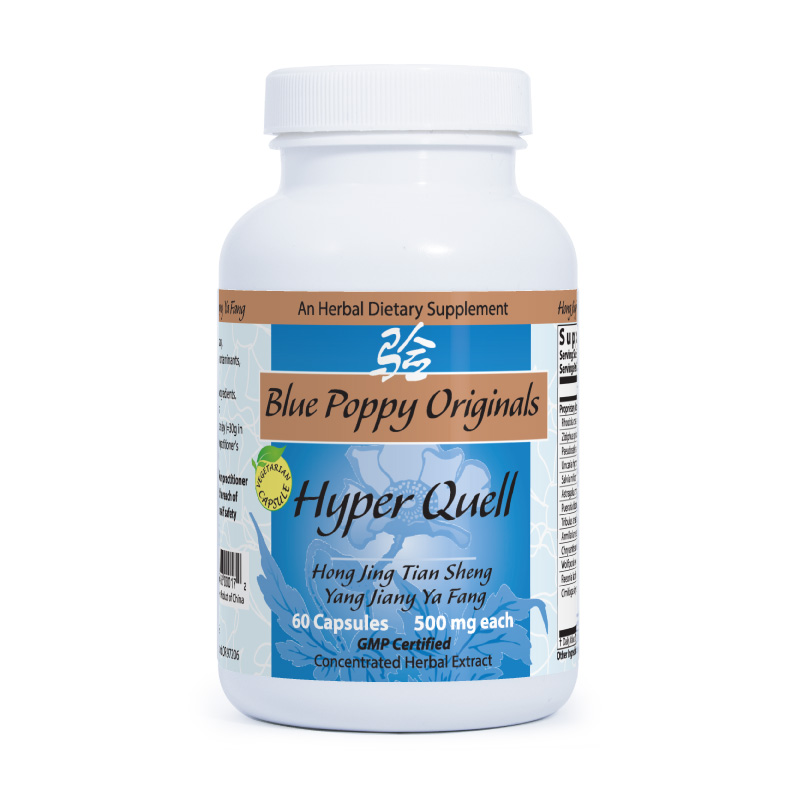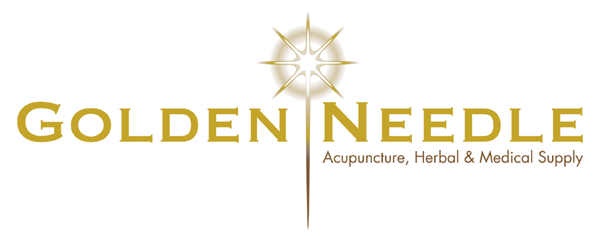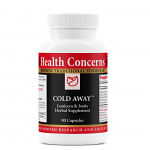Hyperquell, 180 caps

Hyperquell, 180 caps
| SKU | BP117-180 | |
| Brand | Blue Poppy Originals | |
| Unit Size | 180 (10:1 extract) capsules | |
| Dosage | Three capsules two times per day equal not less than 30g of raw medicinals | |
| Potency | 10:1 (average) 500mg | |
| Actions | Supplements the qi, nourishes the blood, and enriches yin, levels wind, clears heat, and quickens the blood, regulates and rectifies the qi mechanism. | |
| Pattern | Qi, blood, and yin vacuity with liver depression and possible wind, heat, and/or blood stasis | |
| Chinese name | Hong Jing Tian Sheng Yang Jiang Ya Fang | |
| English name | Hyperquell, 180 caps | |
| Description | Designed especially to help patients with asymptomatic high blood pressure. Most hypertension involves an inhibited qi mechanism giving rise to depressive heat. By promoting the upbearing of the clear, one resolves that depression and, therefore, clears the heat and discharges the fire that may give rise to internally engendered wind. Although this may seem contradictory to some, in fact, it is not. Clear yang is not the same as ascendant liver yang hyperactivity. In Chinese medical textbooks, hypertension is predominantly associated with ascendant liver yang hyperactivity. However, many patients with hypertension have very few symptoms. Typically, the blood pressure must be quite high before high blood pressure becomes symptomatic. Nonetheless, blood pressure tends to rise with age and many patients suffer from asymptomatic hypertension. Further, in real life, most hypertension patients manifest complex combinations of vacuity and repletion. According to Li Dong-yuans yin fire theory, spleen qi vacuity may result in ascendant liver yang hyperactivity or, at the very least, coexist with such hyperactivity. In that case, simply downbearing yang with heavy, yangsubduing, counterflow-downbearing medicinals (such as Os Draconis, Long Gu, Concha Ostreae, Mu Li, Concha Haliotidis, Shi Jue Ming, and Haemititum, Dai Zhe Shi) may actually work against the successful lowering of the blood pressure. According to Wang Mao-song, in those cases, one must upbear the clear yang at the same time as clearing the liver and extinguishing wind. Upbearing of the clear yang is generally accomplished by combining one of more spleen-fortifying medicinals with one or more acrid, exterior-resolving medicinals. Because the qi mechanisms upbearing and downbearing are reflexive and depression leads to heat and hyperactivity, upbearing of the clear leads to downbearing of the turbid, resolution of depression, and clearing of heat via out-thrusting. According to Yan De-xin, all chronic diseases associated with aging involve at least an element of blood stasis. Hypertension is just such a disease. Modern research with this formula suggests it can lower blood pressure within a week at the same time as it improves heart function and treating heart arrhythmias. It will only reduce the blood pressure if it is a vacuity pattern or blood pressure. This formula can be combined with others to enhance treatment. For marked liver-blood-kidney yin vacuity, add Qi Ju Di Huang Wan. For empty heat symptoms, add Zhi Bai Di Huang Wan. If there are heart palpitations due to malnourishment of the heart spirit complicated by phlegm heat, on may add Blue Poppy Herbs Eleven Flavors Warm the Gallbladder. If high blood pressure is associated with perimenopausal chong and ren disharmony, one might add Blue Poppy Herbs Ultimate Immortals. If there are symptoms of chest bi due to blood stasis, one might add Dan Shen Yin Wan.
One of the lesser known ingredients in Blue Poppy Herbs' formula HyperQuell is Armillaria or the so-called Honey Mushroom. In Chinese, this medicinal is called Mi Huan Jun or Tian Ma Mi Huan Jun, and a number of our customers have asked us for more information on it. Armillaria is widely dispersed in temperate regions throughout the northern hemisphere. For instance, it is found in the San Francisco Bay area and in the British Isles. It is an important wood-rot fungi for both better and worse. However, it is also notable in that some Armillaria species can act as mycorrhizal fungi to support the growth of orchids and other non_photosynthetic plants. In fact, the Armillaria used in HyperQuell is a fungus which grows commensally or in symbiotic association with Rhizoma Gastrodiae Elatae (Tian Ma), the tuber of the orchid, Gastrodia elata. In recent years, Tian Ma has been put on the CITES list of banned wild-crafted Chinese herbs. Tian Ma originally grew wild in the mountainous regions from Yunnan in the southwest to northeast China and Korea, mostly at more than 900 feet above sea level. When this medicinal became popular for the treatment of hypertension in the 20th century in China, its price sky-rocketed and attempts were made to commercially cultivate it. However, this medicinal was difficult to cultivate until the close relationship between Tian Ma and the mycelium of the Honey Mushroom, Armellaria mellea, was discovered. Gastrodia has two unusual requirements for its growth and survival. It requires a fungus, Mycena osmundicola, to sprout its seeds, and Armillaria mellea mushroom mycelia must be incorporated into its tuber in order to maintain its maturation and growth. Because Tian Ma tubers lack the rootlets that normally absorb nutrients from the soil, they rely, instead, on the mycelia of Armillaria to do this for them. When these two requirements were finally understood, the commercial cultivation of Tian Ma became relatively easy, and, by the late '80s, an adequate cultivated supply of Tian Ma was developed in the People's Republic of China. Nevertheless, because Tian Ma grows so slowly, its cost almost equals that of cultivated Ginseng. The good news is that the active medicinal components of Tian Ma are, in fact, mainly the metabolites of the Armillaria mushroom, and batch fermentation of the Armillaria is easily accomplished. This process is similar to how many other medicinal mushrooms, such as Maitake, Shiitake, and Ling Zhi, are now commercially grown. This mycelial material has been continually tested by a number of different research teams in the PRC for more than 25 years, and dozens of published studies have shown that the chemical constituents, pharmacology, and clinical effects of Armillaria and its culture medium after growing the mycelia are indistinguishable from that of Tian Ma. According to these studies, the main active ingredient of Tian Ma is gastrodin, a simple glycoside, comprised of glucose attached to 4_hydroxybenzyl alcohol (HBA). Other active ingredients are the aldehyde form of HBA (4_hydroxybenzylaldehyde), vanillyl alcohol, and vanillin. All of these compounds are chemically similar, all are produced in the mycelia from the same starting materials, and pharmacology studies indicate that they all have similar medicinal effects, such as relieving spasms. The New Drug Group of the Chinese Academy of Medical Science in Beijing has confirmed that Armillaria fermentation liquid does achieve the same medicinal effects as Tian Ma. For example, it can alleviate dizziness due different etiologies, such as hypertension, cerebral basilar ischemia, Meniere's syndrome, and vegetative nervous functional disturbance. It is also effective in the treatment of numbness of the extremities, insomnia, tinnitus, epilepsy, vascular headache, and post_stroke syndrome. In fact, Armillaria is twice as potent gram-for-gram than Tian Ma. At Blue Poppy Herbs, we have long been concerned about environmental issues. More importantly, we have a long track record of "putting our money where our mouth is." We were the first company in our industry to print on recycled and alternative pulp papers using soy-based inks. You'll find recycling bins throughout our plant, and all employees use both sides of every piece of paper. Commitment to the Coalition of Environmentally Responsible Economies (CERES) principles is written into the front of our company operating manual and each employee handbook. Some of our older customers will remember that we were some of the first voices in our industry alerting us to the plight of tigers, rhinoceroses, and bears. Perhaps you remember or, better yet, participated in our "Save the Tiger" t-shirt campaign. Therefore, because Armillaria is 1) just as effective medicinally as Tian Ma, 2) is more potent gram- for-gram than Tian Ma, 3) is easily produced commercially and, therefore, spares an endangered species, and 4) is considerably cheaper than Tian Ma, we at Blue Poppy are excited to be able to use it instead of the better known Tian Ma. This substitution was recommended to us by Bob Quinn, formerly of China International Herbs & Natural Products Inc. and now of People's Herbs in Portland, OR, and we are very grateful to Bob for this advice. Like many Western practitioners of Chinese medicine, we had never heard of Armillaria before Bob brought it to our attention. While this substitution does not lend itself to bulk- dispensed decoctions, it is extremely suitable for commercially manufactured extracts, such as HyperQuell. In this formula, Armillaria has all the same functions and indications as Tian Ma. That means it levels the liver and extinguishes wind, relaxes spasms and resolves tetany, frees the flow of impediment and stops pain. It is indicated for the treatment of both ascendant liver yang hyperactivity and internal stirring of liver wind resulting headache, dizziness, hypertension, epilepsy, pediatric convulsions, tonic-clonic spasms, opistohotonus, and cerebral vascular disease or stroke. It may also be used for wind damp impediment resulting in pain and/or numbness of the low back and extremities. |
|||||||||||||||||||||||||||
| Ingredients |
|
|||||||||||||||||||||||||||










